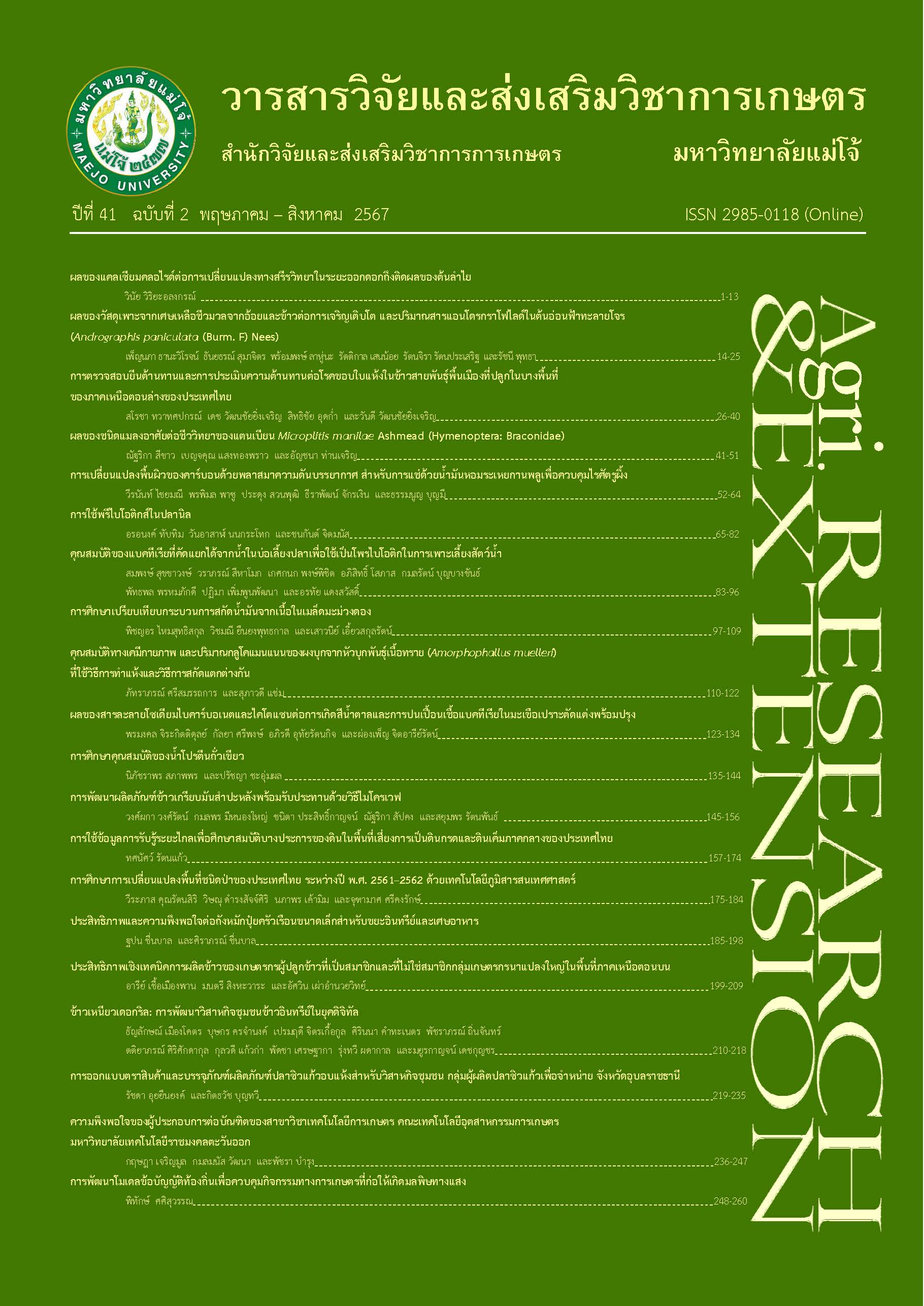การเปลี่ยนแปลงพื้นผิวของคาร์บอนด้วยพลาสมาความดันบรรยากาศ สำหรับการแช่ด้วยน้ำมันหอมระเหยกานพลูเพื่อควบคุมไรศัตรูผึ้ง
DOI:
https://doi.org/10.14456/jare-mju.2024.25คำสำคัญ:
Tropilaelaps, ผึ้ง, คาร์บอน, เทคโนโลยีพลาสมาความดันบรรยากาศ, น้ำมันหอมระเหยกานพลูบทคัดย่อ
Tropilaelaps เป็นไรศัตรูผึ้งที่มีการแพร่ระบาดในอุตสาหกรรมการเลี้ยงผึ้ง โดยไรชนิดนี้สามารถทำลายตัวอ่อนผึ้ง ทำให้ตัวอ่อนผึ้งตายและอาจส่งผลให้รังผึ้งล่มสลายในที่สุด ซึ่งงานวิจัยนี้เป็นการศึกษาผลของพลาสมาความดันบรรยากาศชนิดเจ็ทโดยแก๊สอาร์กอนด้วยแรงดันไฟฟ้าแหล่งจ่าย 4.758 กิโลโวลต์ และความถี่ 829.901 กิโลเฮิร์ต ต่อการเปลี่ยนแปลงคุณสมบัติการ ดูดซับ การระเหย และการปลดปล่อยน้ำมันหอมระเหยกานพลูของคาร์บอน พบว่าคาร์บอนที่ผ่านการฉายพลาสมาที่อัตราไหลของแก๊สอาร์กอนเท่ากับ 1 ลิตร/นาที นาน 60 วินาที มีค่าการดูดซับน้ำมันหอมระเหยกานพลู ได้สูงสุดเท่ากับ 0.0080±0.0003 ไมโครลิตรต่อมิลลิกรัมน้ำหนักแห้งของวัสดุ น้ำมันหอมระเหยมีการปลดปล่อยสูงขึ้นในชั่วโมงที่ 4-8 หลังผ่านพลาสมา และในชั่วโมงที่ 72 คาร์บอนมีการปลดปล่อยอยู่ในช่วง 17.127±2.212 ถึง 21.513±2.330 ไมโครลิตรต่อมิลลิลิตร นอกจากนั้นยังพบว่าอัตราการระเหยของน้ำมันกานพลูบนวัสดุคาร์บอนมีค่าสูงสุดในชั่วโมงที่ 2 ของการทดลอง ซึ่งคาร์บอนที่ไม่ได้ผ่านพลาสมามีอัตราการระเหยสูงสุด เท่ากับ 0.2442±0.0807 ไมโครลิตรต่อกรัมต่อชั่วโมง แต่ไม่มีความแตกต่างกันอย่างมีนัยสำคัญทางสถิติระหว่างกลุ่มทดลอง จากผลการวิจัยในครั้งนี้จะใช้เป็นแนวทางในการหาสภาวะที่เหมาะสมของพลาสมาในการเพิ่มประสิทธิภาพของวัสดุตัวกลางในการดูดซับและปลดปล่อยน้ำมันหอมระเหยเพื่อใช้ในการควบคุมไรผึ้งได้
เอกสารอ้างอิง
Atwal, A.A. and N.P. Goyal. 1971. Infestation of honey bee colonies with Tropilaelaps, and its control. Journal of Apicultural Research 10: 137-142.
Bendifallah, L., R. Belguendouz, L. Hamoudi and K. Arab. 2018. Biological activity of the Salvia officinalis L. (Lamiaceae) essential oil on Varroa destructor infested honeybees. Plants 7: 44.
Boonmee, T., L. Wongthaveethong, C. Sinpoo, T. Disayathanoowat, J.S. Pettis and V. Chaimanee. 2022. Surface modification of materials by atmospheric–pressure plasma to improve impregnation with essential oils for the control of Tropilaelaps mites in honeybees (Apis mellifera). Applied Sciences 12: 5800.
Burgett, D.M. and C. Kitprasert. 1990. Evaluation of Apistan as a control for Tropilaelaps clareae (Acari, Laelapidae), an Asian honey bee brood mite parasite. Ameican Bee Journal 130: 51-53.
Burgett, M., P. Akratanakul and R.A. Morse. 1983. Tropilaelaps clareae: a parasite of honeybees in South–East Asia. Bee World 64: 25-28.
Burley, L.M., R.D. Fell and R.G. Saacke. 2008. Survival of honey bee (Hymenoptera: Apidae) spermatozoa incubated at room temperature from drones exposed to miticides. Journal of Economic Entomology 101: 1081-1087.
Camphor, E.S.W., A.A. Hashmi, W. Ritter and I.D. Bowen. 2005. Seasonal changes in mite (Tropilaelaps clarae) and honeybee (Apis mellifera) populations in apistan treated and untreated colonies. Apiacta 40: 34-44.
Chaimanee, V., N. Warrit, T. Boonmee and J.S. Pettis. 2021. Acaricidal activity of essential oils for the control of honeybee (Apis mellifera) mites Tropilaelaps mercedesae under laboratory and colony conditions. Apidologie 52: 561-575.
Damiani, N., L.B. Gende, P. Bailac, J.A. Marcangeli and M.J. Eguaras. 2009. Acaricidal and insecticidal activity of essential oils on Varroa destructor (Acari: Varroidae) and Apis mellifera (Hymenoptera: Apidae). Parasitology Reserach 106: 145-152.
de Guzman, L.I., G.R. Williams, K. Khongphinitbunjong and P. Chantawannakul. 2017. Ecology, Life History, and Management of Tropilaelaps Mites. Journal of Economic Entomology 110: 319-332.
Denes, F.S. and S. Manolache. 2004. Macromolecular plasma-chemistry: an emerging field of polymer science. Progress in Polymer Science 29: 815-885.
Gaire, S., M.E. Scharf and A.D. Gondhalekar. 2019. Toxicity and neurophysiological impacts of plant essential oil components on bed bugs (Cimicidae: Hemiptera). Scientific Reports 9: 3961.
Haarmann, T., M. Spivak, D. Weaver, B. Weaver and T. Glenn. 2002. Effects of fluvalinate and coumaphos on queen honey bees (Hymenoptera: Apidae) in two commercial queen rearing operations. Journal of Economic Entomology 95: 28-35.
Huang, Y., Q. Yu, M. Li, S. Jin, J. Fan, L. Zhao and Z. Yao. 2021. Surface modification of activated carbon fiber by low–temperature oxygen plasma: textural property, surface chemistry, and the effect of water vapor adsorption. Chemical Engineering Journal 418: 129474.
Junka, A., A. Zywicka, G. Chodaczek, M. Dziadas, J. Czajkowska, A. Duda-Madej, M. Barttoszewicz, K. Mikolajewicz, G. Krasowski, P. Szymczyk and K. Fijalkowski. 2019. Potential of biocellulose carrier impregnated with essential oils to fight against biofilms formed on hydroxyapatite. Scientific Reports 9: 1256.
Kaushik, N.K., N. Kaushik, N.N. Linh, B. Ghimire, A. Pengkit, J. Sornsakdanuphap, S.-J. Lee and E.H. Choi. 2019. Plasma and nanomaterials: fabrication and biomedical applications. Nanomaterials 9: 98.
Kim, J.H., J.H. Han, S. Hong, D.-W. Kim, S.H. Park, J.-H. Wee, K.S. Yang, Y.A. Kim. 2021. Effect of plasma surface modification on pullout characteristics of carbon fiber–reinforced cement composites. Carbon Trends 3: 100030.
Kongpitak, P., G. Polgar and J. Heine. 2008. The efficacy of Bayvarol and Checkmite+ in the control of Tropilaelaps mercedesae in the European honey bee (Apis mellifera) in Thailand. Apiacta 43: 12-16.
Liu, S.-J. and S.-C. Liao. 2021. Surface modification of bamboo charcoal by O2 plasma treatment and UV-grafted thermos-sensitive AgNPs hydrogel to improve antibacterial properties in biomedical application. Nanomaterials 11: 2697.
López-García, J., F. Cupessala, P. Humpolícek and M. Lehocký. 2018. Physical and morphological changes of poly(tetrafluoroethylene) after using non-thermal plasma treatments. Materials 11: 2-10.
Lubis, R.W., T.E. Saraswati, U.H. Setiawan and K. Kusumandari. 2019. Surface modification of activated carbon using an atmospheric pressure dielectric barrier discharge (DBD) plasma jet. IOP Conference Series: Materials Science and Engineering 578: 012010.
Mullin, C.A., M. Frazier, J.L. Frazier, S. Ashcraft, R. Simonds, D. vanEngelsdorp and J.S. Pettis. 2010. High levels of miticides and agrochemicals in North American apiaries: implications for honey bee health. PLoS ONE 5: e9754.
Nuanjohn, T. and V. Chaimanee. 2019. Effectiveness of some essential oils for control of Tropilaelaps mercedesae mites in honeybees (Apis mellifera). King Mongkut’s Agricultural Journal 37: 43-50. [in Thai]
Park, H. and K.Y. Lee. 2007. Plasma-treated poly(lactic-co-glycolic acid) nanofibers for tissue engineering. Macromolecular Research 15: 238-243.
Yanling, C., W. Yingkuan, P. Chen, S. Deng and R. Ruan. 2014. Non-thermal plasma assisted polymer surface modification and synthesis: a review. International Journal of Agricultural and Biological Engineering 7: 1-9.
Zhang, C., M. Zhao, L. Wang, L. Qu and Y. Men. 2017. Surface modification of polyester fabrics by atmospheric-pressure air/He plasma for color strength and adhesion enhancement. Applied Surface Science 400: 304-311.
ดาวน์โหลด
เผยแพร่แล้ว
รูปแบบการอ้างอิง
ฉบับ
ประเภทบทความ
สัญญาอนุญาต
ลิขสิทธิ์ (c) 2024 วารสารวิจัยและส่งเสริมวิชาการเกษตร

อนุญาตภายใต้เงื่อนไข Creative Commons Attribution-NonCommercial-NoDerivatives 4.0 International License.
บทความนี้ได้รับการเผยแพร่ภายใต้สัญญาอนุญาต Creative Commons Attribution-NonCommercial-NoDerivatives 4.0 International (CC BY-NC-ND 4.0) ซึ่งอนุญาตให้ผู้อื่นสามารถแชร์บทความได้โดยให้เครดิตผู้เขียนและห้ามนำไปใช้เพื่อการค้าหรือดัดแปลง หากต้องการใช้งานซ้ำในลักษณะอื่น ๆ หรือการเผยแพร่ซ้ำ จำเป็นต้องได้รับอนุญาตจากวารสาร





